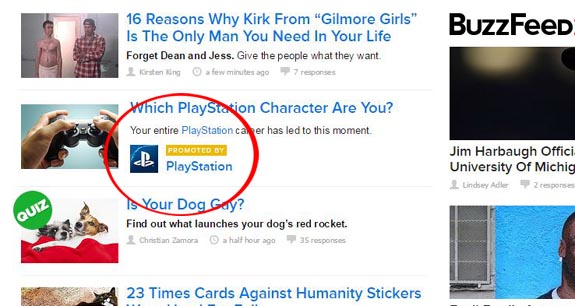It’s not that native advertising is an entirely new concept. It has been around for a very long time, well before the Internet got nearly as huge as it is today. Part of the reason why it has become such a big buzzword in the last while is that we are seeing more and more of a “pay to play” model across many channels. Even if you were able to grow your Facebook following in a legitimate and organic way, Facebook wants you to open up your wallet if you actually want to reach all the people who clicked “Like” on your Facebook page.
In effect, buying one of those sponsored updates in a Facebook news feed is a form of native advertising. It’s meant to blend in with all the regular, non-paid content that the regular user would see on a daily basis. The native advertisement is designed in such a way that the style and look is virtually indistinguishable from regular content, except under those FTC regulations, it needs to be appropriately labeled as sponsored content.
But how is native advertising all that different from content marketing? Or are they actually the same thing? Well, there is some definite crossover between the two and you’ll find that some forms of content marketing can also be called native advertising and vice versa. However, there are also some notable differences and this continues to be a topic of debate among Internet marketers. Different people will tell you different things.

Native advertising is content that is sales-oriented and it is designed to look and feel like regular, non-sponsored content on an external website. If you’ve ever seen sponsored tweets or sponsored posts, you’ve seen some form of native advertising. This content can be written by the advertiser or it can be written by the website owner.
Another example could be an article about buying a digital camera and, embedded in the post are some “recommended” products from Canon. The ideal is when native advertising is custom-tailored to a single web property, as it aids in creating this indistinguishable nature. While native advertising can provide some value to the reader, its primary objective is to generate leads and sales.
Content marketing, others have said, is more about the creation of content on a brand’s own web properties, cultivating trust among followers and customers. A mortgage broker, for example, could have a weekly newsletter with tips about how to get the best mortgage or recent mortgage trends.
This helps to foster a long-term relationship. Each individual piece of content marketing isn’t necessarily geared toward generating a sale right that moment; it’s more about providing added value.The material is meant to be relevant and useful, guiding potential leads down a longer sales funnel.
That’s just one perspective. As you make your way around the Internet, you’ll surely find many more. It is just as legitimate to include guest posts as part of a greater content marketing strategy, for instance. Content marketing could also involve branded infographics that strive to get shared in a viral manner for free. And perhaps that’s another differentiating factor: the publisher will always be compensated with native advertising, but the arrangement with content marketing may not always be so clear. It could just happen organically.
Whatever you want it call it, both content marketing and native advertising are here to say and they will only become more commonplace in the years to come.
Go Download John Chow’s New eBook and Live The Dot Com Lifestyle!!
